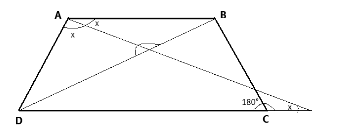
How many obtuse angles does a trapezoid have\[?\]
Answer
535.8k+ views
Hint: The trapezoid is coming under quadrilateral shape. Where it contains four sides. Here in this question to find how many obtuse angles in a trapezoid have. By considering the trapezoid ABCD and to the trapezoid by using the properties of supplementary angles we are going to find the obtuse angles in the trapezoid.
Complete step by step solution:
A trapezoid, also known as a trapezium, is a flat closed shape having 4 straight sides, with one pair of parallel sides. The parallel sides of a trapezium are known as the bases, and its non-parallel sides are called legs. It can have right angles (a right trapezoid), and it can have congruent sides (isosceles), but those are not required.
An obtuse-angled triangle is a triangle in which one of the interior angles measures more than \[{90^ \circ }\] degrees. In an obtuse triangle, if one angle measures more than \[{90^ \circ }\], then the sum of the remaining two angles is less than \[{90^ \circ }\].
Consider a Trapezoid ABCD

The sum of the angles in any quadrilateral is \[{360^ \circ }\], and the properties of an isosceles trapezoid dictate that the sets of angles adjoined by parallel lines (in this case, the bottom set and top set of angles) are equal.
By using the properties of supplementary angles i.e.,
Two angles are said to be supplementary angles when they add up to \[{180^ \circ }\] degrees. Two angles are supplementary, if
One of its angles is an acute angle and another angle is an obtuse angle.
Both of the angles are right angles.
This means that
$\angle A $ + $\angle B$ = \[{180^ \circ }\]
Trapezoid ABCD has two pairs of supplementary angles. Then Both supplementary angles cannot be obtuse at the same time.
Hence A trapezoid can have two obtuse angles at most.
So, the correct answer is “2”.
Note: In geometry we have different kinds of geometrical figures. On the basis of the sides of the geometrical figure we classify them. These figures also contain angles namely, acute angle, right angle and obtuse angle. To determine the angle we must know about the complementary angle and supplementary angles.
Complete step by step solution:
A trapezoid, also known as a trapezium, is a flat closed shape having 4 straight sides, with one pair of parallel sides. The parallel sides of a trapezium are known as the bases, and its non-parallel sides are called legs. It can have right angles (a right trapezoid), and it can have congruent sides (isosceles), but those are not required.
An obtuse-angled triangle is a triangle in which one of the interior angles measures more than \[{90^ \circ }\] degrees. In an obtuse triangle, if one angle measures more than \[{90^ \circ }\], then the sum of the remaining two angles is less than \[{90^ \circ }\].
Consider a Trapezoid ABCD

The sum of the angles in any quadrilateral is \[{360^ \circ }\], and the properties of an isosceles trapezoid dictate that the sets of angles adjoined by parallel lines (in this case, the bottom set and top set of angles) are equal.
By using the properties of supplementary angles i.e.,
Two angles are said to be supplementary angles when they add up to \[{180^ \circ }\] degrees. Two angles are supplementary, if
One of its angles is an acute angle and another angle is an obtuse angle.
Both of the angles are right angles.
This means that
$\angle A $ + $\angle B$ = \[{180^ \circ }\]
Trapezoid ABCD has two pairs of supplementary angles. Then Both supplementary angles cannot be obtuse at the same time.
Hence A trapezoid can have two obtuse angles at most.
So, the correct answer is “2”.
Note: In geometry we have different kinds of geometrical figures. On the basis of the sides of the geometrical figure we classify them. These figures also contain angles namely, acute angle, right angle and obtuse angle. To determine the angle we must know about the complementary angle and supplementary angles.
Recently Updated Pages
Master Class 12 Business Studies: Engaging Questions & Answers for Success

Master Class 12 Economics: Engaging Questions & Answers for Success

Master Class 12 English: Engaging Questions & Answers for Success

Master Class 12 Maths: Engaging Questions & Answers for Success

Master Class 12 Social Science: Engaging Questions & Answers for Success

Master Class 12 Chemistry: Engaging Questions & Answers for Success

Trending doubts
Which places in India experience sunrise first and class 9 social science CBSE

Fill the blanks with the suitable prepositions 1 The class 9 english CBSE

Write the 6 fundamental rights of India and explain in detail

Difference Between Plant Cell and Animal Cell

What is pollution? How many types of pollution? Define it

What is the full form of pH?




